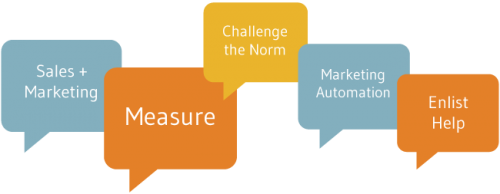
We’ve worked with lots of B2B companies – some with a Chief Marketing Officer (CMO), some without, some with a good one, some with a bad one. As an agency, we’ve not only observed, but also lived through a wealth of strategies and practices that have both worked and failed. From our experiences, these five bits of advice to the business-to-business CMO emerged.
1. Be your sales team’s best friend.
We can’t stress enough the importance of marketing and sales being in sync with one another. Yet at so many companies, they butt heads. When you as CMO fully understand the objectives of your sales team, your ability to generate qualified leads for them will improve dramatically. On the flip side, the sales team needs to respect the work marketing is putting in to bring these leads to the table. And they need to do something with those leads, tracking them in a CRM (customer relationship management) system like Salesforce throughout their buying process. The more you can facilitate a strong relationship between your two parties, the more effective you’ll both be.
2. Measure everything. Everything.
The overwhelming shift of B2B marketing to an online setting has made today’s marketing environment a land of measurable data. There are no subjective ratings or estimated ad impressions anymore. With tools like Google Analytics at our disposal, we instead have cold, hard numbers – always up-to-date, accurate and readily available to you. And that means measuring the ROI of every marketing effort is now possible. Define what marketing success means for your business – what actions a prospect might take that can be considered a win. These should include lead capture activities like newsletter subscriptions, case study downloads and consultation requests. Then learn how measure which marketing activities are contributing (and not contributing) to making those things happen.
3. Challenge your company’s marketing norm.
For years B2B marketing was about trade journal ads, trade shows and rounds of golf. Though still a part of the mix, the reality is that most people now start their research online. This article by Eloqua (a respected marketing voice) states that “78% of B2B buyers start their research with search.” In other words, more than 3/4 of your prospects are likely pretty far along in their research process before your sales team ever gets a chance to shake their hands at that trade show. As CMO, its your job to make sure your website has already started the sales process for you, educating prospects in the meantime. Shift your marketing mindset and challenge the traditional approach. Just because your company has done it in the past doesn’t mean its the right way to do it.
4. Start learning about marketing automation. Right now.
Marketing automation is the future of marketing. I’ll bet the farm on it. In short, it’s an software-based marketing system that involves nurturing leads from their first point of contact with your business to the point at which they become a customer. Marketing automation software platforms like Hubspot integrate business blogging, website calls-to-action, lead-capture forms and automated email to market to your prospects based on who they are as well as the actions they’ve taken on your website. The end result is highly targeted lead generation and nurturing that marries the marketing and sales processes. This is marketing intelligence at its finest, and right now presents the opportunity for you to be an innovator by embracing it.
5. Don’t go it alone.
Hire a good marketing agency. Yes, I’m biased – I co-own a marketing firm. But the truth is this: You as a CMO are one person. Your time and energy should not be spent making print ads in PowerPoint or adding pages to a website built in 1998. Your job is marketing strategy – and the result of your work should be qualified lead generation. That’s no small task and it needs your full attention. A good marketing agency will help you refine your strategy as well as execute it across multiple professional skill sets including writing, art direction / design, web development and project management. Those are more hats than one person can or should wear.